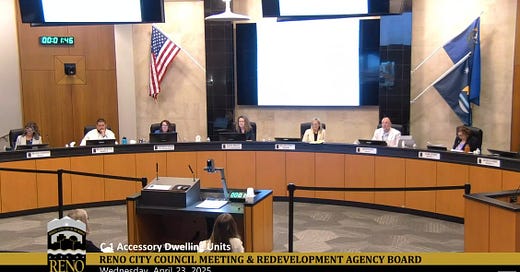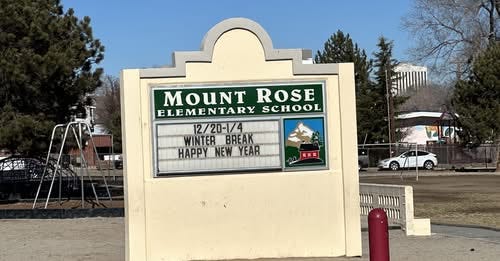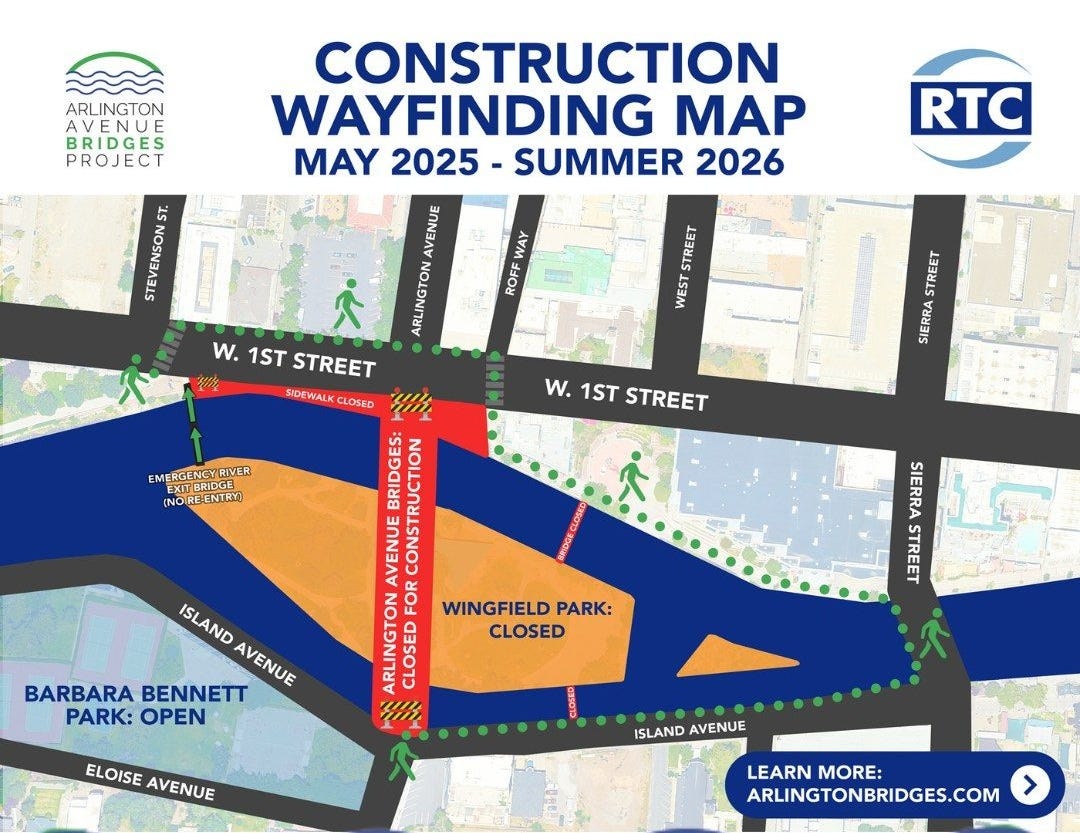Prioritizing Public Process
From the ADU ordinance to permit applications to a questionable legislative bill to regulate the Planning Commission, you play an important role in local governance.
Well, I thought I could just wait until this weekend to update you on the April 23rd Reno City Council meeting and other recent developments, but there’s just been too much going on to fit into a standard Brief. So here’s a midweek bonus edition to get everyone caught up before we move on to next week.
NOTE: I will be writing about the April 21st Redevelopment Agency Advisory Board (RAAB) meeting in my next Brief as part of my preview of the May 7th Redevelopment Agency Board meeting. That’s when a decision is likely to be made about using Tax Increment Financing (TIF) for the Grand Sierra Resort’s arena project. So stay tuned for that.
Topics I’ll cover today include what’s next for Accessory Dwelling Units (ADUs); a surprise bill draft at the State Legislature that could result in significant changes to the Reno Planning Commission; Mayor Schieve’s concerns about the Sundowner and Events Center; various alerts and requests for community input, and more.
City Budget Workshops scheduled for Monday, May 5
First, a heads-up that two special meetings have popped up on the calendar for Monday, May 5th at 10am—budget workshops for the Reno City Council (agenda here) and Redevelopment Agency Board (agenda here). The materials for both meetings have been posted, so check those agendas to access staff reports, draft fee schedules, department summaries, and capital improvement project summaries.
On a related note, the City just posted a memo with the 8-page, illustrated Quarterly Financial Report for January 1, 2025 - March 31, 2025.
RECAP: The April 23 Reno City Council Meeting
You can read the City of Reno’s official City Council meeting highlights here. City Manager Bryant also gave a quick update in the latest “On the Agenda” podcast, along with an interview with Parks & Recreation Director Nathan Ullyot. Some items on the agenda were covered by the press and some not. Let’s take a look.
The Plumas Redevelopment Project
As you’ve likely heard, City Council narrowly upheld (4-3) the approval to construct a large apartment complex on South McCarran Boulevard. Here’s coverage of that:
Council approves Plumas redevelopment despite traffic and safety concerns (Kelsey Penrose, This is Reno, 4/27/25)
Reno council greenlights Lakeridge apartment project despite neighborhood protests (Jaedyn Young, Reno Gazette-Journal, 4/25/25)
City planning staff will revise the draft ADU Ordinance
City Council’s discussion of the proposed new ordinance to enable and regulate Accessory Dwelling Units was covered by multiple media outlets—here’s just a few:
Reno City Council Requests New Draft of Rules and Regulations for Accessory Dwelling Units (Makayla Hardy, KTVN, 4/24/25)
City council moves forward with ADU ordinance after decades of debate (Kelsey Penrose, This is Reno, 4/28/25)
What’s not covered in detail there was what I consider a near misstep precipitated by Ward 5 Councilmember Devon Reese. During the lengthy discussion, the Mayor and Councilmembers provided substantial feedback to staff regarding their own opinions and the massive amount of public input that had been submitted to the City through months of public outreach—as well as comments offered during the meeting.
The Staff Report presented Council with two basic options: send the original draft ordinance to the Planning Commission without any changes, or indicate to staff the changes that City Council would like to make to the draft before sending it to the Planning Commission for their final input on a revised version.
Toward the end of the discussion, Ward 2 Councilmember Duerr suggested that City staff might convene a working group of residents to help formulate a final draft including specific design standards and other factors. She hoped staff could come up with a final draft based on Council feedback and then return with that draft to secure their approval of the final wording—then take it to the Planning Commission.
Councilmember Reese stated his preference to just send the draft ordinance to the Planning Commission without any new changes, let them look at it and make their own suggestions, and then have it return to the City Council in exactly the form it has been for months, accompanied by a Staff Report with the Planning Commission’s input. Then City Council would have to make any desired revisions to the ordinance immediately before adopting it, rather than taking the time to put together the draft they want now.
Reese suggested that he didn’t want Council to make any new changes to the draft before sending it to the Planning Commission because he wanted the PC “to have some role in it,” but that makes no sense. That commission already provided staff with their comments on this version. They just met about it last month (March 19th). Now it’s City Council’s job to synthesize that input along with the survey, all the public feedback, and their own opinions, in order to give the Planning Commission a new draft that they think encapsulates what the community thinks, wants, and needs.
Here’s City planner Grace Mackedon explaining what the Planning Commission already provided them and what Council could do now. Councilman Reese said he thought the Planning Commission had to watch Council’s discussion anyway (which they don’t—just as Council doesn’t have to watch theirs) and that the Planning Commission would have a “better opportunity” to review the lot size question than Council did at their meeting (which also makes no sense—Council had the same information and maps that the PC would and this was the time for them to make more specific recommendations).
Councilmember Duerr responded that the entire process of public input would seem to have been wasted if City Council didn’t update the draft ordinance before sending it back to the Planning Commission, saying she had read the comments from her NAB and the other NABs, had listened to public comment, and wanted to synthesize what she’d heard and learned since they all read the original draft, last year.
Fortunately, City planner Grace Mackedon, who took in all the public comment at the NABs along with comments from the Planning Commission and City Council, suggested that she incorporate all of that feedback into a revised draft complete with additional guardrails and modified lot size, and take both that draft and the original draft to the Planning Commission to get their input, and after that, come back to City Council for a potential reading of the ordinance.
Councilmember Reese seemed to think that was giving the people who provided public comment at the April 23 meeting more power than they should have, which I think fundamentally missed the point that Duerr was making: that Council’s job was to incorporate not just what they heard in the room that day, but all of the feedback gathered over past months.
I wish Council had given Ms. Mackedon a bit more specific direction regarding their desired changes, but I have faith in her ability to synthesize what she’s heard, and I’m looking forward to seeing the revised draft that she puts together based on all of this input. We should next be seeing this at a future Planning Commission meeting where that body will offer their final thoughts on the revised draft (comparing it to the original), and then forward it to City Council for potential tweaks and eventual adoption (which requires two readings at two separate meetings).
Lastly, like most people including several City Councilmembers, I don’t understand why the City isn’t already moving forward to adopt some kind of regulation of short-term rentals (STRs), which is what some fear most ADUs would be used for.
Downtown Updates - Code enforcement, the ReStore program & more
The Downtown Updates portion of the Council meeting always includes so much information, but most of is not included in the tables of statistics that are presented but is instead delivered verbally, which makes it difficult to keep track of the various announcements, programs, and initiatives that staff discusses. I really wish there were a better way for the public to access all this news after it’s presented there.
For instance, Mayor Schieve drew attention to the condition of the old Sundowner Hotel-Casino building at the corner of West 4th Street and Arlington Avenue (on the west side of the old Bonanza Inn, which Jacobs Entertainment recently purchased and plans to convert into multi-family housing). Here’s an older story about it from 2022.
The Mayor’s expressed desire for the Sundowner’s owner to come in front of City Council to explain its poor condition led to a whole discussion of code enforcement, revealing that for the first time in 20 years, the City has a code enforcement officer dedicated to the downtown area, and that multiple code cases are currently open on the Sundowner, as they are on “every block in the downtown core.” The Mayor then asked City Attorney Karl Hall what more they could do to enforce code compliance, and he indicated that those who fail to comply could be cited for a misdemeanor. In the meantime, they apparently can (and do) issue $1000 fines every two weeks.
Revitalization Manager Bryan McArdle gave a rundown of the properties that have recently completed work funded by the “ReStore” grant program, but I really wish there were one centralized list of recipients along with descriptions of the work completed on the ReStore webpage. The current Redevelopment Agency budget is proposing to dedicate a million dollars total to another round of these grants, and I think it’s critical for residents to have a detailed list of what they have funded so far—with photos. In the meantime, we have to rely on news pieces like this one for hints:
Reno’s Downtown plan to fill empty storefronts (Noah Bond, KOLO-8, 4/30/25)
LEGISLATIVE UPDATE: Reno is quietly sponsoring a bill that could give City Council the ability to remove Planning Commissioners at will.
In his April 23 legislative update to City Council, the City’s lobbyist, Nic Ciccone, casually mentioned Senate Bill (SB) 48 along with dozens of other bills currently working their way through the State Legislative session.
In his initial quick description of it, Ciccone explained that SB 48 began as a completely different bill sponsored by Las Vegas that they had graciously “given” to Reno, which had altered it to be “just a coterminous planning commissioners bill for the City of Reno” with an additional section changing certain reporting dates.
It came up again briefly during Council discussion, when Councilmember Reese brought it up to get clarification that the bill would not require a planning commissioner to live in the same ward as the Councilmember who appointed them, and that this legislation would not change the regulations governing Reno’s Planning Commission but would enable the City of Reno to pass its own ordinance to do so.
Because the City of Reno had decided back on January 22 to adopt a legislative platform that would not introduce their own bill requests but simply prioritize efforts to promote affordable housing, I looked back to see if there had ever been any public direction to Ciccone to work on this bill. I didn’t find any.
In his March 12th update to City Council, Ciccone did mention that the City of Reno was working with the City of Las Vegas to amend SB 48 “to include some of the language about coterminous Planning Commission terms” for the Planning Commission and City Council but that it was primarily about other issues. There was no further discussion at that time.
However, on April 9th, Ciccone submitted a proposed amendment to SB 48 that resulted in a completely rewritten Senate Bill 48. Here’s the bill’s page. As written, it would allow the City of Reno to adopt an ordinance that could do two things:
First, as mentioned earlier, it could make the term of each member of the planning commission “coterminous with the term of the member of the governing body who recommended the appointment to the appointing authority” (which, honestly, I’m not even sure is a good idea considering the learning curve required for both new Planning Commissioners and new City Councilmembers).
But it also includes this section:
5. Except as otherwise provided in this subsection, members of a county or city planning commission may be removed, after public hearing, by a majority vote of the governing body for just cause. In a county whose population is 700,000 or more, members of a county or city planning commission serve at the pleasure of their appointing authority. The governing body of a county or city in any county whose population is 700,000 or less may adopt an ordinance whereby members of a county or city planning commission serve at the pleasure of their appointing authority. [emphasis added]
In other words, the Reno City Council could adopt an ordinance allowing them to remove a planning commissioner without a public hearing or a majority vote of the public body for just cause. Instead, those commissioners would simply “serve at the pleasure of their appointing authority.” In other words, they could be removed at any time by City Council without a stated reason or a public process.
It’s impossible for me not to read this without recalling what transpired at the February 12th City Council meeting, when Ward 1 Councilmember Kathleen Taylor was so irate that some of Reno’s Planning Commissioners differed with her and staff’s interpretation of the role of the City’s Master Plan in decision-making that she read a written statement into the record expressing her lack of faith in them. Would she have led the charge to remove them from the commission on the spot if she could have? Is that a power that members of our City Council should have?
Not only did Nic Ciccone not describe this newly amended bill in detail in any of his public updates to Reno City Council (it is the only one the City is sponsoring!), but City staff did not even discuss it with the current Reno Planning Commission. In fact, in the legislative hearing just this morning (April 30), three of Reno’s current Planning Commissioners—Manny Becerra, Silvia Villaneuva, and chair Kerry Rohrmeier—called in to testify against the bill as written. You can listen to their testimony here, and I hope you will (there’s a short pause before they start to speak).
I find all of this extremely troubling—not just because I don’t see any public direction by the City Council to even pursue this, but because the City of Reno has an established history of introducing bills at the state legislature to advance specific political aims, and it’s not a good pattern. Let’s all give this issue our full attention.
Here’s a few more recent updates from the legislative session:
Fire regionalization bill gutted to focus solely on study (Kristen Hackbarth, This is Reno, 4/23/25)
Legislative proposals would nudge, aid municipalities toward infill development (Michael Lyle, Nevada Current, 4/29/25)
Artists approved to design public art at the Public Safety Center
Reno City Council funds $375,000 for public art at new police station despite absent design (Kelsey Penrose, This is Reno, 4/25/25)
Minor Conditional Use Permit DENIED for proposed Jiffy Lube on the corner of Hunter Lake & Mayberry Drives
Word came down yesterday that City of Reno has denied a minor conditional use permit request to operate a Jiffy Lube at the corner of Hunter Lake and Mayberry Drives. The reason, however, was unexpected and not directly related to all the public protest. As Councilmember Naomi Duerr wrote on Facebook, the permit was denied “because the location selected is already in use as a required overflow parking location for the Raley's across the street. In 1996, when Raley's wanted to expand at this location, one of the requirements was that they have a certain amount of parking to account for the loss of parking on site. That requirement is still in place.” You can read the staff’s letter of explanation to the applicant here.
Staff only rediscovered this encumbrance after a tip from a former City staff member. As Councilmember Duerr explained, “While old permit records are retained, they are kept offsite, often on microfiche (film copies of old records) and not easily accessible.”
I’m pleased that the combination of someone’s personal memory and staff research was able to unearth the encumbrances placed on this parcel decades ago, but honestly, it’s quite concerning that those requirements didn't transfer to whatever system the City is currently using to keep track of such things, or that this history wasn’t uncovered in the first round of research following the application. It makes me fear for what other requirements or conditions attached to specific parcels are being ignored because they didn't make the transition from paper to the digital era.
I also want to point out that while the permit was not denied directly because of the extensive public protest, it was that intense public engagement that led to widespread media coverage of the issue and to Councilmember Duerr’s decision to hold the NAB meeting at City Hall in order to guarantee enough capacity to house all concerned residents. Information presented at the NAB meeting prompted staff to look into the matter more deeply, resulting in the subsequent discovery and determination.
As the letter indicates, the applicant can appeal the decision, and this encumbrance could be removed with an amendment to the original Raley’s permit, which would be a public process. I'm sure we'll be seeing more discussion of this soon. I want to especially thank Councilmember Duerr for her steadfast encouragement of citizen engagement and for her continuing efforts to make neighborhood development more consistent and predictable. Here’s some coverage of the matter from the RGJ:
City denies Jiffy Lube permit in west Reno, but developer can appeal (Jaedyn Young, Reno Gazette-Journal, 4/29/25)
Mayor Schieve doesn’t want to pay the RSCVA an annual amount for the Reno Events Center anymore
Apparently three years after agreeing to pay the RSCVA more than $300K per year for the next ten years to support the downtown Reno Events Center, Mayor Schieve has changed her mind. This is Reno has the story:
City of Reno wants to stop paying RSCVA for downtown events center (Bob Conrad, This is Reno, 4/29/25)
I’ll be bringing this up again in my next Brief, since the potential impact of the Grand Sierra’s Arena on the Events Center has been brought up repeatedly in that discussion.
NEWS DIGEST: The Latest in Local Urban Development
A few more recent articles of note:
In Nevada, $100K income considered middle class — and may not cover all expenses (Jeffrey Meehan, Reno Gazette-Journal, 4/22/25)
Troubled Reno Kimpton site hit with auction notice by lender (Jason Hidalgo, Reno Gazette-Journal, 4/23/25)
Lakeridge Golf Course project looking to add boutique hotel, various amenities (Jason Hidalgo, Reno Gazette-Journal, 4/28/25)
Scenic Nevada Alert: Digital Signs in Neighborhoods
The nonprofit organization Scenic Nevada has issued a new alert concerning the City of Reno’s latest draft of its Sign Ordinance, which would allow all public and private schools in the City to install digital signs on premises. You can read the full alert here.
The group explains, “Right now, no one in Reno, including schools, can have a digital sign within 750 feet of a residentially zoned property without public hearings and a conditional use permit. This law has worked to protect residential neighborhoods, where most Washoe County schools are located, from day-and-night digital signs.”
The message also includes an update on the regulations covering signage in the Entertainment District. The previous draft would have allowed any property in the Mixed-Use Downtown Entertainment Zoning District to have unlimited signage, but as the City explains, this has been modified to pertain only to gaming properties:
Based on feedback received, the second public draft of proposed amendments allows for the unlimited signage to only be applicable to nonrestricted gaming facilities. The Mixed-Downtown Entertainment District will now follow the same sign regulations as all other Urban Districts.
The revised Sign Ordinance is still in draft form, and you can read the alert for more details and information for how to contact local officials with any concerns.
REMINDER: Wingfield Park and the Arlington Bridges to close for construction starting Monday, May 5th
Beginning Monday, May 5, Wingfield Park and the two bridges over the Truckee River along Arlington Avenue will be closed through the summer of 2026 as the RTC constructs the new Arlington bridges. More info on that project here.
LAST CHANCE: Take the Community Survey TODAY!
I devoted my entire April 26th Brief to listing all the topics that are covered in the City of Reno’s current Community Survey, to try to convey the breadth of issues, policies, and actions the City is hoping you will help them rank and prioritize.
You can find the survey here: https://www.reno.gov/government/strategic-priorities/community-survey. The deadline to participate is TODAY, April 30.
I’ve had a few readers email me expressing frustration about what is not included and the limitations of how input is being collected (mostly through multiple choice selections), and while I do share some of those concerns, I think it’s still critical to participate. When these results are brought to City Council this summer, we’ll all have the opportunity to provide additional comments. But if you don’t participate in this phase, you will have missed an opportunity for your rankings and priorities to be tabulated in the initial assessment of broad community sentiment. So just do it!
City Seeks Input on Proposed Rate Increase for Sewer Service and Expansion of Sewer Utility Assistance Program
Lastly, from the Latest News section of the City website: “The City of Reno is seeking input on proposed sewer rate increases. A recent study shows the need for a rate increase to ensure the City’s sewer system and related infrastructure continue to operate reliably, safely, and efficiently. The proposed 8 percent increase would go into effect on October 1, 2025, and a second rate increase of 8 percent would go into effect the following year in October 2026. The City is also considering expanding its sewer utility assistance program for those that meet eligibility criteria.”
Learn more about this proposed increase and how to submit your comments here.
Enjoy the rest of the week and I’ll be back this weekend with some discussion of the Grand Sierra Resort’s application for redevelopment financing. See you then.
Be sure to check out my Citizen Guide for helpful resources and links to help anyone become more informed and engaged in issues related to urban development (& more) in Reno.
You can view this and prior newsletters on my Substack site, subscribe to receive each new edition in your email inbox, and follow the Brief (and contribute to the ongoing conversation) on X, Facebook & Instagram. If you feel inspired to contribute, you may purchase a paid subscription through Substack or contribute via Venmo at @Dr-Alicia-Barber or via check to Alicia Barber at P.O. Box 11955, Reno, NV 89510.






